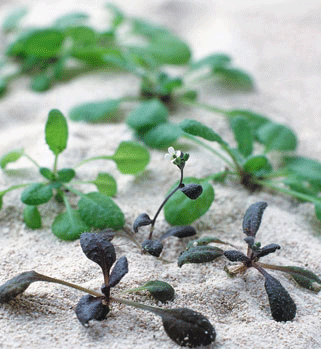GoodMagazine reports that that Denmark-based ARESA has conducted successful field tests with its genetically modified Thale Cress, for use in land mine detection.
Thale Cress, also known as Arabidopsis thaliana, commonly called arabidopsis, or mouse-ear cress, has a short life cycle – six weeks from germination to mature seed.The ARESA modified Thale Cress is very sensitive to nitrogen, which is a component of the explosives in land mines, and emitted in tiny amounts.
Photo (Aresa) by Henrik Freek; via GoodMagazine.
The Thale Cress
has been genetically modified to provide a natural warning in the presence of land mines. Thales cress is inherently sensitive to nitrogen dioxide, a chemical byproduct of land mines. The Copenhagen-based biotech company Aresa tweaked the weed’s genes so that its leaves would turn from their natural green to bright red in the presence of latent explosives. Field tests have thus far been successful, meaning traditional methods of human and canine mine detection may soon have a less dangerous alternative.
From Ben Jervey’s post in Good Magazine .While there are good reasons to have reservations about the genetic modification of plants, until and unless the powers that have been responsible for placing land mines start removing them, this seems an excellent technology.
Ben Jervey is also the editor of GreenAppleGuide
.
